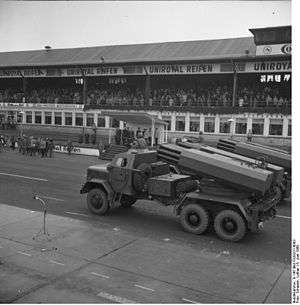Light Artillery Rocket System
| Light Artillery Rocket System | |
|---|---|
 | |
| Type | Multiple rocket launcher |
| Place of origin | West Germany |
| Service history | |
| Used by |
West Germany Greece Portugal[1] |
| Production history | |
| Produced | 1969 |
| Variants | LARS II |
| Specifications | |
| Weight | 15,000 kg (33,000 lb) |
| Length | 7.8 m (25 ft 7 in) |
| Width | 2.5 m (8 ft 2 in) |
| Height | 2.9 m (9 ft 6 in) |
| Crew | 3 |
|
| |
| Shell |
Length: 2.26 m (7 ft 5 in) Weight: 35 kg (77 lb) |
| Caliber | 110 mm (4.3 in) |
| Elevation | 0° to 55° |
| Traverse | 105° |
| Rate of fire | 36 rounds in 18 seconds |
| Muzzle velocity | 640 m/s (2,100 ft/s) |
| Maximum firing range | 14 km (8.7 mi) |
| Filling weight | 17.3 kg (38 lb) |
|
| |
| Armor | yes |
Main armament | 36 barrels |
Secondary armament | One roof mounted Rheinmetall MG 3 |
| Engine |
8-cylinder multi-fuel 178 HP at 2,300 rpm |
| Suspension | Wheeled 6x6 chassis |
Operational range | 500 km (310 mi) |
| Speed | 73.6 km/h (45.7 mph)[2] |
The Light Artillery Rocket System (or LARS) is a series of West-German vehicle mounted multi-barrel rocket launchers designed for rapid concentration of fire on designated targets. The rockets are of 110 mm caliber. The usual mounting was a lightly armoured Magirus or MAN 6x6 truck.[3] 36 rockets were mounted in two clusters of 18. The weapon entered service in 1969 and was phased out by 1998 and replaced by the M270 Multiple Launch Rocket System.[4]
| Wikimedia Commons has media related to Leichtes Artillerieraketensystem. |
References
- ↑ Hogg, Ian (2000). Twentieth-century artillery. New York: Barnes & Noble Books. p. 310. ISBN 0760719942. OCLC 44779672.
- ↑ Foss, Christopher (1977). Jane's pocket book of towed artillery. New York: Collier. p. 149. ISBN 0020806000. OCLC 911907988.
- ↑ Army recognition LARS 110 SF 1 Système lance roquette multiple sur camion
- ↑ 110 mm Light Artillery Rocket System (LARS) rockets - Jane's Ammunition Handbook
External links
This article is issued from
Wikipedia.
The text is licensed under Creative Commons - Attribution - Sharealike.
Additional terms may apply for the media files.